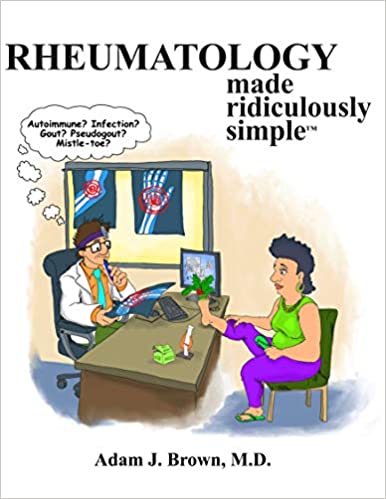Rheumatology Made Ridiculously Simple (2020) is a concise and clear overview of rheumatology. The book starts with a discussion of how to evaluate patients with joint pain, and then proceeds with a detailed overview of the diagnoses and management of all the important rheumatological diseases including rheumatoid arthritis, systemic lupus erythematosus (SLE), the spondyloarthropathies and more. There are also useful chapters on laboratory testing in rheumatological diseases, as well as pharmacotherapy.
Generally, the discussions are very straightforward and suitable for most better than average medical students. However, rheumatology is a speciality of subtlety and nuance, and the book does a very good job in situations where such treatment is required. Take for example the discussion of scleroderma, the prototypical disease of skin hardening and fibrosis. There are three important mimics to keep in mind, and the author does a great job explaining how to distinguish them from each other clinically:
- Eosinophilic fasciitis: younger patient with skin thickening on distal forearms; associated with exercise and peripheral eosinophilia; no finger involvement.
- Morphea: localized, patchy hardening of the skin without hand involvement (sclerodactaly or Raynaud’s phenomenon)
- Nephrogenic systemic fibrosis: history of exposure to gadolinium contrast

As you can see, this type of presentation is very useful, both clinically and for preparation for standardized examinations such as the United States Medical Licensing Examination (USMLE).
It’s really, really, hard to find much fault with this book. The author is quite obviously a master in his field and a master educator too. And unlike some of the other books in the “Ridiculously Simple” series, Rheumatology Made Ridiculously Simple (2020) is a serious book written by a serious author who is quite obviously an expert in his specialty. I therefore think future editions of this book deserve a less irreverent cover (see above). Also, I suspect that the chapter on pharmacotherapy (Chapter 2) should be placed after the chapter on laboratory testing (Chapter 17). This would be more consistent with the way diseases are approached in medicine more generally: patient history, then physical examination, then workup, then treatment.
It’s very hard for me to find any additional ways to improve this book. I therefore recommend Rheumatology Made Ridiculously Simple (2020) to medical students and residents and to non-rheumatologist attendings who are interested in brushing up on the specialty.


Leave a Reply